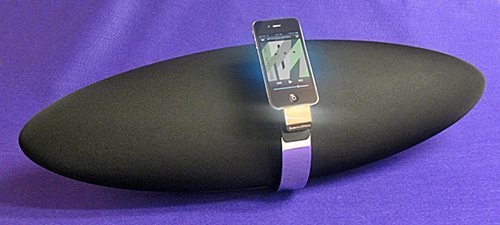
I’ve read in a few audiophile articles that a good, reasonably priced set of stereo speakers paired with an amplifier will trump the best iPod speaker/dock no matter the cost. While that may be true, when I heard the Bowers & Wilkins Zeppelin Air, I began to have some doubts. The British company, Bowers & Wilkins is famous for some of the best (and expensive) speakers available. They’ve ventured out into the highly competitive iPod/iPhone market with innovative products like the original Zeppelin iPod speaker/dock, the MM-1 computer speakers, P5 headphones and the new C5 in-ear headphones. B&W have become popular not only because of their product’s forward design, but because they sound even better than they look.
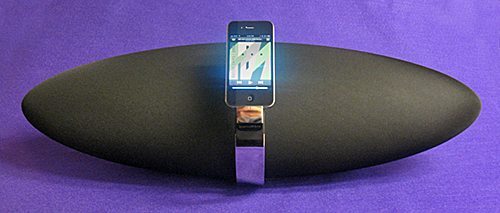
Case in point: Last summer, I attended a friend’s wedding. Since he and his fiancee were getting married in an old, wooden chapel, there was no wired sound system available. It fell on him to supply any music beyond an upright piano, so he asked if I had any ideas. Well, it just so happens, I had received the Zeppelin Air the previous day, and I thought this would be a perfect testing opportunity. Boy, was it ever. After hiding the Zeppelin at the back of the small stage, I then sat in the second row pew with remote in hand ready to press the play button at just the right moment we had rehearsed. The perfect exit song was cued on my docked iPod Classic. When the moment arrived, I pressed Play and … nothing. After a few awkward moments, I realized that the Zeppelin had shut down since it was just sitting there and not doing anything. So, once I recovered from this little heart attack, I pressed the On and then Play button when suddenly, the whole chapel was filled with the Turtles singing “Happy Together.” It was magical. No distortion, no harsh frequencies; just music. Everyone assumed the sound was from a larger speaker system somewhere in the chapel. The bride and groom’s exit was flawlessly timed with the music as they walked past the smiling guests. This was a great test.
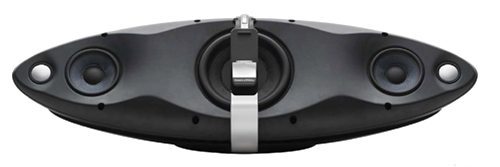
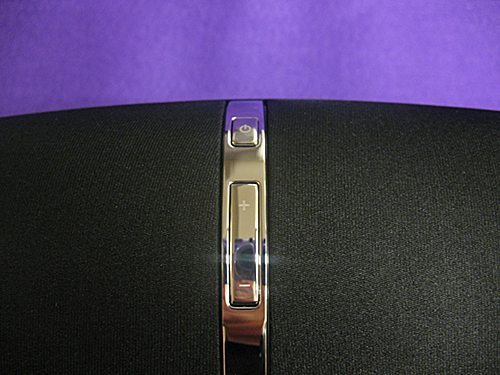
The Zeppelin Air lives up to Bowers & Wilkins design and quality standards. It has 2 x 1 in. aluminum tube tweeters, 2 x 3 in. midrange speakers, one 5 in. subwoofer and digital signal processing packed into a gorgeous 150 watt package. There is nothing like it anywhere. It screams “look at me” with its all black plastic and cloth covered elongated football shape. It really does look like a zeppelin. Well, a zeppelin with a 30-pin easy-to-grasp iPod dock attached and a slim, shiny metal divider that contains on/off and volume buttons. It also has a dedicated digital audio converter (DAC), which is important because it overrides whatever DAC your computer or iPod/iPhone uses. B&Ws MM-1 computer speakers use the same DAC and trust me, you want B&W’s DAC instead of the one your current device uses. The difference is that great. The digital signal processing chip allows the Zeppelin to sound big and powerful without distortion. Like the MM-1 speakers, you can’t push the Zeppelin Air beyond where it can safely go. That makes for big, distortion-free and “safe for the speakers” audio.
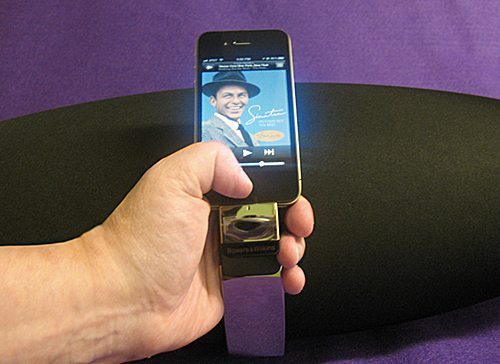
The Zeppelin Air is almost completely redesigned even though it looks and costs the same as the previous version. Upgraded speakers each have their own amp (5 amps total), Ethernet, and Apple’s AirPlay are now included.
Airplay is the big draw here.
Think of AirPlay as Bluetooth on steroids. With AirPlay, you can wirelessly stream music from your computer, iPod touch/iPad/iPhone in CD quality. Bluetooth can’t even touch it for musical quality. As I write this review in my studio building, I’m streaming Apple Lossless music from my iMac using iTunes to the Zeppelin Air across the room. There are no snags, dropouts or other audio anomalies. There is only a slight delay when I press Play (and Skip) in iTunes. Incidentally, this is why you can’t watch video on your iPad using AirPlay with the Zeppelin Air. That slight delay throws audio and visual syncing out the window.
If you have the required wifi where you plan to use the Zeppelin Air, setting up is a one-time affair, but not very intuitive. There’s a lot of “do this” and “don’t do that.” Plus I had to set up wireless AirPlay while wired to an ethernet cable. Think about that for a minute. The good news is that B&W have recently provided an alternative, wireless method for setting up AirPlay. Go here to see the new info. It just wasn’t available when I did the setup. There is also a helpful video tutorial on the B&W web site.
After that, you’re good to go. Whether it’s iTunes on your computer, iPad, or iPhone, the AirPlay icon is available. Just click it, choose the Zeppelin and that’s it. Even out in my studio, which is about 100 feet from my house, the Zeppelin Air with my iMac worked just fine off the Cisco router in my house, without any signal boosters or repeaters. Note that the regular iPod doesn’t do wireless, so you will need the attached dock.
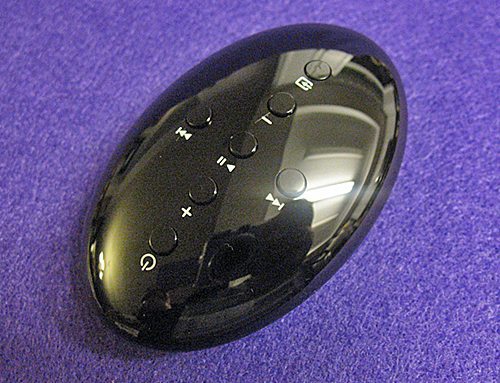
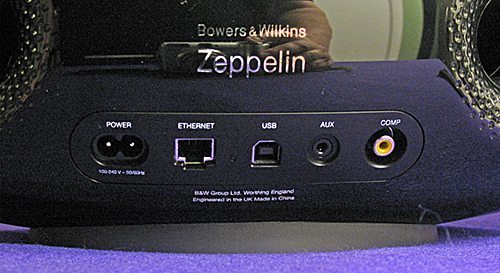
Included is an egg shaped remote with play/pause, on/off, volume up and down and a button that switches among the different connections on the back of the unit. Those choice of connections located at the rear of the unit are: Ethernet for hooking up the network, USB for a wired computer connection and firmware updates, AUX for music players other than Apple or digital connection and Composite video output so you can use the Zeppelin Air with your TV if you wish. There are two bass ports (Flowport) with “golf ball” dimples that B&W says improves airflow resulting in better bass at any volume. These little design cues help make the Zeppelin Air visually striking from any angle. However, good luck seeing what color the tiny lights are on the front of the Zeppelin Air from across the room. Each color means something and I can never remember what. I have to keep referring to the manual.
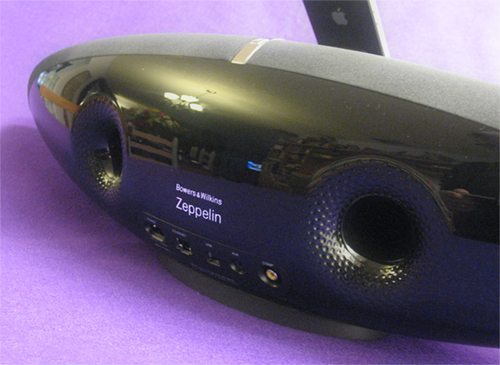
Upgraded specs and cool features like AirPlay are nice, but how does the Zeppelin Air sound? For this review, I decided to play some of my “go-to” songs. These are songs that I know intimately and if there is anything out of place or other audio oddities, I’ll hear it immediately.
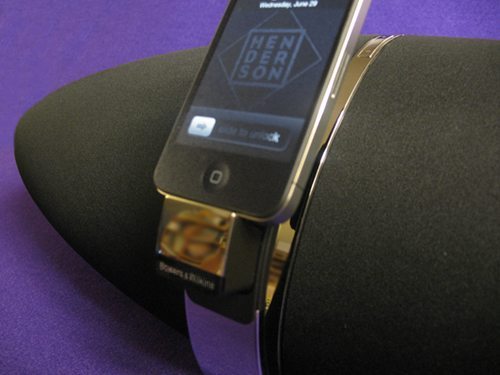
While preparing what I was going to listen to, I discovered something surprising. I’ve always been a fan of The Beatles and when the remasters came out in late 2010, I grabbed both the stereo and mono mixes. Since few people owned stereos in the 60s, The Beatles spent all of their energy on mono leaving the stereo mixes to recording engineers and producers. Only “Let It Be” and “Abbey Road” were stereo only. While those mono mixes may be what The Beatles wanted us to hear and are great from a historical perspective, I preferred the stereo mixes because to me, they had more impact and life (purists may argue that point). However, while walking around the room letting the sound of The Beatles in mono bounce off furniture, walls, etc., these mixes sometimes trumped the stereo versions. The reason is simply based on the Zeppelin’s limitations. Even though the Zeppelin Air has amazing audio, the fact that it is an all-in-one unit diminishes stereo separation at a distance. There is simply no way a single speaker unit can beat separate (quality) speakers spread farther apart. But in The Beatles case, it allowed the mono mixes to compete more favorably with the stereo versions, leveling the playing field, so to speak. This helped me understand better why some preferred mono over stereo.
I recently purchased Neil Young’s remastered “Harvest” CD album. “Harvest” is arguably one of the best albums of the 70s and a favorite in my collection. “Out On the Weekend” opens the album with Young singing in sync with a thumping bass and drum line letting his voice rise and fall in time to the insistent beat. The raw power and a lonely harmonica come through with a clarity I haven’t heard in this song before. Part of this aural ecstasy is the remastering that Young supervised himself, but a good bit of the credit also goes to the Zeppelin Air. Remember, this is wireless from my iMac, not a docked iPod. The files are lossless and streaming at full resolution (not possible with bluetooth) through the Zeppelin’s DAC and DSP processors.
AC/DCs “Thunderstruck” has always stood out among heavy metal songs with its pristine production. The song begins with a blistering guitar riff from Angus Young which doesn’t let up until the end. As the song begins, you can hear each string individually struck and then the rest of the band kicks in with a thunderous onslaught. While the rest of the group’s wall of sound rolls on, Young’s guitar licks remain clear and biting. With its separate sub, mids and tweeters, the Zeppelin Air keeps this song from dissolving into a mess as it so often does on lesser speakers. This is a dock made for loud rock.
Then there’s Pink Floyd. I downloaded the 2011 remastered “Saucerful of Secrets” and turned the volume up. Knowing that the title song of this album was released in 1967 and not exactly audiophile quality, I wanted to give it a shot because I know this song completely; every note, every beat, every thing. Wow. Even though the download is a barely respectable 256kbps, it played at ear piercing levels with no distortion other than what is already present in the original. I heard sounds that I hadn’t before and the thundering noise that is sandwiched between Nick Mason’s drum solo and Richard Wright’s organ playing reminded me of the scene from “Close Encounters of the Third Kind” when the mother ship appears over Devil’s Mountain. This low end rumbling can cause an unpleasant buzz in many speakers, but not with the Zeppelin Air. Wright’s church-sounding organ riffs that close out the song had both lows and highs together but each sounding distinct and not bleeding into one another. The song has always been an amazing, psychedelic masterpiece but now, it has never sounded better.
After “Saucerful of Secrets,” I had to try “Welcome to the Machine” from “Wish You Were Here.” This is a song custom made for headphones with its severe, mechanical left-right stereo effects. As I mentioned earlier, a bit of that stereo separation is lost due to the close proximity of the Zeppelin’s speakers, but boy, does it pack a punch.
For a classical piece, I listened to “Heroes’” from Philip Glass’s orchestral tribute to David Bowie and Brian Eno, “Heroes Symphony.” Complete with Glass’s trademark repetitions, the title track rumbles and soars, like a musical bird in flight. The piece switches between delicate and booming over and over, back and forth, leaving the listener exhausted at the end. The Zeppelin Air didn’t care that I had the volume jacked up to complaining-neighbor level.
It may not seem like it in this review, but I’m not a fan of really loud music for long periods, but the clarity of the Zeppelin Air kept me from lowering the volume to a sociable level. I was happy as a clam alone in my studio with all those decibels assaulting me for hours.
One other song I had to try with the Zeppelin Air was Roxy Music’s “If There Is Something” from their self-titled 1972 debut album. This song contains some ear-splitting sax playing by Andy Mackay that can’t be truly appreciated unless it borders on painful. On the Zeppelin Air, it does and it was thrilling.
There is no headphone port on the Zeppelin Air, which, to me, is a serious omission. You might wonder why a headphone jack would be desirable, given the fact that this is a speaker dock, after all. But if used as a computer speaker, wouldn’t you want to take advantage of the onboard digital audio convertor instead of the inferior DAC in your computer for those times you need to use headphones? I would.
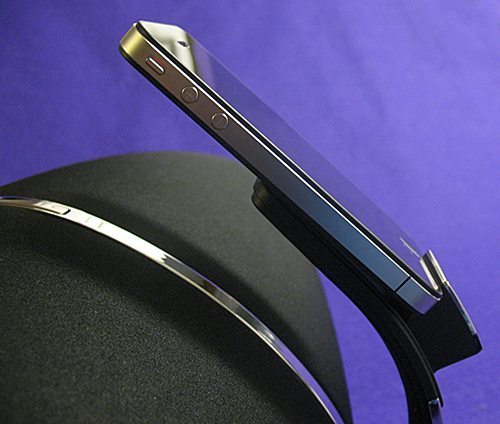
Bowers & Wilkin’s Zeppelin Air is an expensive speaker dock. There’s no getting around that. B&W equipment has never come cheap, but the Zeppelin Air does look and sound as expensive as it is. But consider; if you compare the Zeppelin Air to an equally good amp and speaker setup and are tight for space, then the price looks more realistic. Also, since it is one of the few speaker docks featuring Apple’s AirPlay technology, it has an air of exclusivity (but not for long because many more AirPlay speakers are coming).
Let’s just say this up front: If you are looking for a holiday gift for someone who is into music and you have the money, then you need to hear the Zeppelin Air. There is no other iPod dock as good or as audacious. It is much, much better looking than my photographs.
Update 1: After the review was finished, I updated the firmware which completely broke my wireless connection. It took over an hour to figure out how get it back. It was not fun and a very convoluted fix for a $600 product. Plus, it was the weekend and tech support was not available until the following Monday, so after following the manual and much trying and retrying, I finally got it working again. I’m still not really sure what I did, though. I received an email from B&W early the next week with some helpful directions. From now on though, I think I’ll hold off doing the firmware thing unless absolutely necessary.
Update 2: Bowers & Wilkins has released an iPhone app – Zeppelin Air – for music sharing. If you are having a party, you and your friends can download the app, create playlists on each iPhone and let the Zeppelin Air choose among the iPhones randomly for a mix of musical styles from various partygoers. The app can be found in the iTunes store.
Apple iPhone 14, 128GB, Purple - Unlocked (Renewed)
Apple iPhone 14 (Renewed), 128GB, Midnight - Unlocked
Product Information
| Price: | $599 US |
| Manufacturer: | Bowers & Wilkins |
| Retailer: | Bowers & Wilkins |
| Requirements: |
|
| Pros: |
|
| Cons: |
|

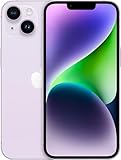

Gadgeteer Comment Policy - Please read before commenting
I’ve had one in the kitchen/dining area for about a month and I love it for streaming Pandora and Spotify as well as tracks from iTunes. The sound is incredible and very balanced so long term listening is a pleasure. My very expensive stereo system is just out of wifi range and has no remote so the combination of sound quality and convenience of the Zepplin is hard to beat. No, it doesn’t sound quite as good as the big system, but it does sound so good that I do want to listen to it – unlike any boom box that I have heard.
Do you intend to bring out an android speaker dock.
Iphones are catered for.
Hi Martin,
Since AirPlay is an Apple technology, B&W won’t be releasing an Air version of the Zeppelin for Android. B&W could be working on a Zeppelin with an Android connection, but I have no knowledge whether they are or not.
Bill H.
great review!
i’m very picky. sometimes i need to walk away and let someone else do the driving! with that being said…. pls choose for me,
the b&w zepp or the bose wave tower. the choice is yours and i won’t hold it against you. ponder wisely… i await your response.
Robert,
I don’t know what a Bose Wave Tower is. If you mean the Wave Music System, then I would pick the Zeppelin. It has a built-in subwoofer which has deeper bass. I have my Zeppelin on the back of my upright piano and it is used every day. It’s wonderful. Plus it uses Apple Airplay, which will spoil you fast. Understand that setting up airplay is not fun, but if you follow the instructions, it should be OK. Also be aware that stereo separation will not be terrific, but that is true with any dock system.
Hope this helps,
Bill H.
Thank you Bill for that complete and useful review. Do you know if there is a chance to connect the Zeppelin with a ps3. I use the ps3 to watch blue ray films and at the moment I use the tv speakers that sounds like crap.
Any ideas? The ps3 has bluetooth.
Thanks
Fran
Fran,
I am not familiar with a Sony PS3. I can tell you that the Zeppelin Air does not have bluetooth, only Apple’s AirPlay for wireless.
If you are looking for a bluetooth only speaker, I would recommend the Audyssey Audio Dock (formally the South of Market dock speaker).
I love this speaker. It’s sound quality is a shade less than the Zeppelin, but not by much. This is a killer speaker. Here is my review of it if you are interested:
http://the-gadgeteer.com/2011/07/09/south-of-market-audio-dock-speaker-review/
… and Audyssey’s web:
http://www.audyssey.com/products/audio-dock
After owning the ZepAir for about 6 months, I decided to connect to Air Play. I tried 3 times and gave up. I followed each step and get through to the last stage but the purple light keeps blinking without stopping every time…I gave up. ;-( Any pointers?
Carlo, there is a firmware update using USB. Follow the directions for updating and see if that works. If not, contact the B&W support people. They are very good at troubleshooting and will get back to you within a couple of days. Let me know if that works.
Bill
I recommend using the ipad app for setting up the zep air airplay, so much easier.
Jon,
You are absolutely correct. When I reviewed the Air, the app didn’t exist (and I didn’t own an iPad). Now, it it soooo easy to set up. And it STILL sounds fantastic!